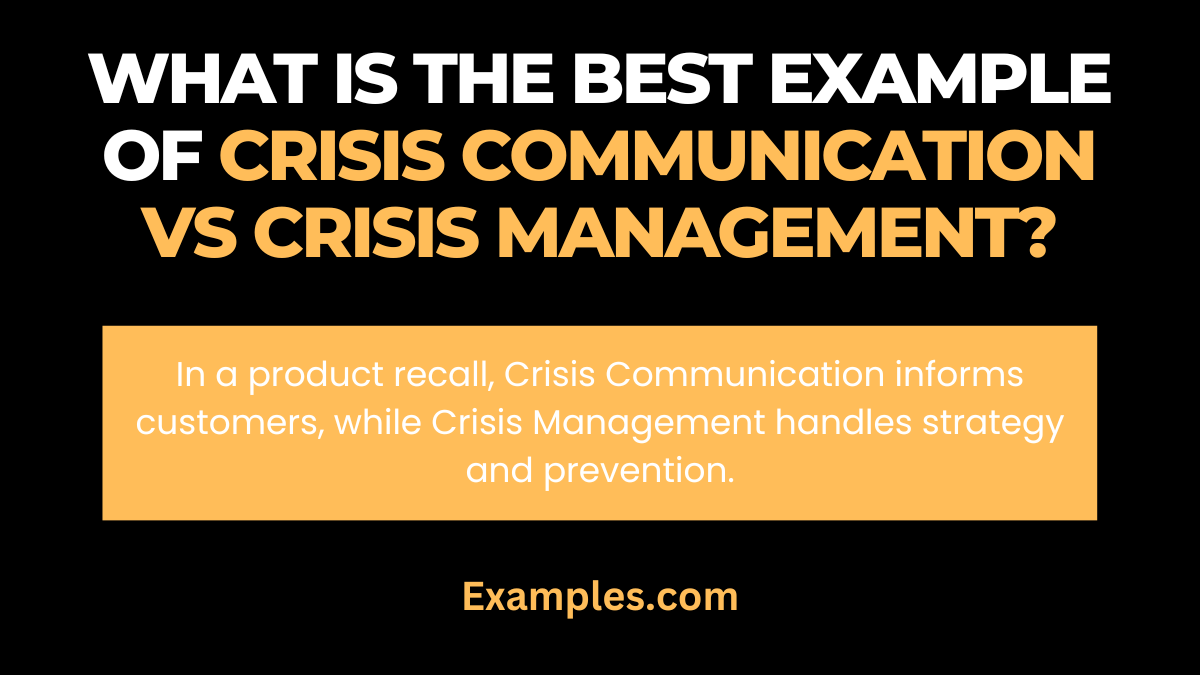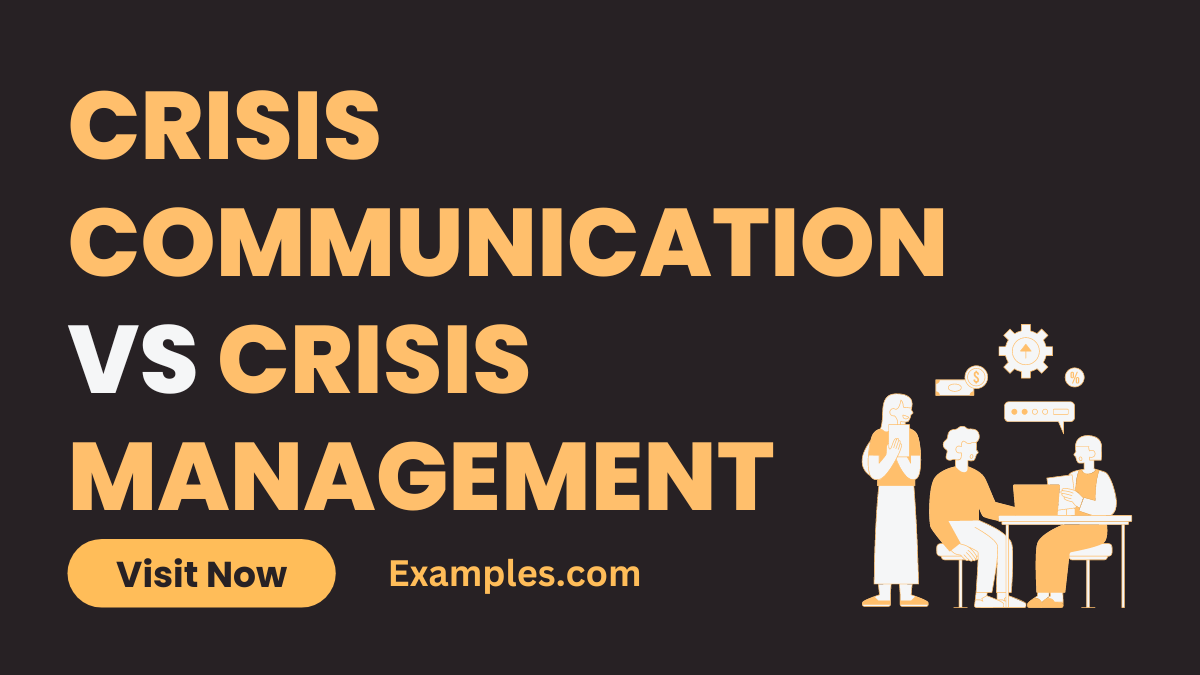Crisis Communication vs Crisis Management – 9+ Examples
Distinguishing between Crisis Communication and crisis management is crucial for successful crisis resolution. This section will delve into their unique roles and how they complement each other in managing crises. While Crisis Communication focuses on the messaging and information dissemination during a crisis, crisis management encompasses the overall planning, response, and recovery efforts. Understanding these differences is essential for effective leadership and strategy in high-pressure situations.
What is Crisis Communication vs Crisis Management?

Crisis Communication and crisis management are two interrelated, yet distinct, aspects of handling emergencies. Crisis Communication specifically refers to the way organizations communicate with stakeholders during a crisis, focusing on the delivery of clear, accurate, and timely information. Crisis management, on the other hand, is the broader process of preparing for, responding to, and recovering from a crisis, encompassing strategic planning, resource allocation, and decision-making.
What is the Best Example of Crisis Communication vs Crisis Management?

A prime example of the distinction between Crisis Communication and crisis management can be seen during a product recall. Crisis Communication in this scenario involves informing customers about the recall, explaining the risks, and providing instructions for product returns. Crisis management, meanwhile, includes the strategic planning behind the recall, the coordination with suppliers and retailers, and measures to prevent future occurrences, showcasing a comprehensive approach to resolving the crisis.
Difference Between Crisis Communication and Crisis Management

The distinction between Crisis Communication and crisis management is crucial in navigating organizational challenges. Below is a table highlighting the key differences:
| Aspect | Crisis Communication | Crisis Management |
|---|---|---|
| Primary Focus | Communication to stakeholders during a crisis | Overall coordination and strategy in handling a crisis |
| Objective | Ensure accurate and timely dissemination of information | Implement strategies to address and resolve the crisis |
| Role | Deliver clear and reassuring messages | Plan and execute crisis response and recovery |
| Timing | Active during the peak of the crisis | Active before, during, and after the crisis |
| Key Activities | Press briefings, social media updates, stakeholder communication | Developing contingency plans, resource mobilization, leadership decisions |
| Scope | Limited to managing communication | Broad, encompassing all aspects of crisis response |
| Required Skills | Media relations, empathy, clarity in messaging | Leadership, strategic planning, problem-solving |
| Measurement of Success | Effectiveness of communication reach and public response | Resolution of the crisis and minimization of impact |
| Nature of Response | Reactive, based on current situations | Proactive and preventive, along with reactive measures |
| Ultimate Goal | Maintain or restore public trust and credibility | Ensure the continuity and recovery of the organization |
10 Examples of Crisis Communication
Crisis Communication is pivotal in managing perceptions and maintaining trust during emergencies. It involves clear, transparent, and timely information dissemination to stakeholders. Effective Crisis Communication mitigates panic, maintains reputation, and ensures stakeholders are informed and reassured. Here are ten unique and distinct examples, each demonstrating how to communicate effectively in various crisis scenarios.
- Natural Disaster Alert: “Urgent: Evacuate immediately due to the approaching hurricane. Follow designated routes for safety.” Immediate alerts and safety instructions during natural disasters.
- Product Recall Notification: “For your safety, we’re recalling Product X due to potential risks. Here’s how to return it.” Transparent communication during a product recall, ensuring customer safety.
- Data Breach Announcement: “We’ve had a data breach. We’re taking these steps to secure your data and prevent future incidents.” Prompt acknowledgment of a data breach and reassurance of action.
- Public Relations Issue Address: “We apologize for our recent ad. It was insensitive, and we’re reviewing our approval processes.” Apology and commitment to improvement in response to public backlash.
- Financial Crisis Update: “Despite financial challenges, we’re committed to finding solutions and protecting our team.” Honest updates about financial issues, highlighting commitment and transparency.
- Leadership Misconduct Response: “We are investigating the allegations against our CEO. We take such matters seriously.” Neutral and factual response to allegations involving leadership.
- Service Interruption Communication: “Our services are currently down. We’re working on restoring them as quickly as possible.” Immediate updates during service disruptions, informing about resolution efforts.
- Environmental Incident Report: “We’re responding to the oil spill by working with authorities to minimize environmental impact.” Proactive communication during an environmental crisis, showing responsibility and action.
- Health Crisis Guidelines: “Please follow these health guidelines to protect yourself during the ongoing health crisis.” Informative communication providing health guidelines in a crisis.
- Legal Issue Statement: “We’re addressing our current legal challenges with integrity and commitment to our values.” Communicating legal challenges while maintaining a commitment to ethics and transparency.
10 Examples of Crisis Management
Crisis management encompasses the strategies and actions taken to deal with emergencies effectively. It includes planning, response, resolution, and post-crisis analysis. Effective crisis management minimizes the impact of crises and aids in quick recovery. Below are ten examples of crisis management, each illustrating specific actions and decision-making processes in various situations.
- Natural Disaster Response Plan: “Activate our emergency response team and set up relief centers in affected areas.” Implementing a disaster response plan with immediate action and resource allocation.
- Product Recall Execution: “Initiate the recall process, inform distributors, and set up customer helplines for returns.” Organized execution of a product recall, focusing on customer safety and efficient returns.
- Data Breach Containment: “Secure breached systems, assess data impact, and notify affected users with steps to protect themselves.” Immediate actions to contain a data breach and protect user data.
- Public Relations Recovery Strategy: “Develop a recovery campaign to rebuild trust and address concerns raised by the public.” Strategic public relations efforts to repair reputation and regain public trust.
- Financial Restructuring: “Implement cost-saving measures and explore new revenue streams to stabilize finances.” Strategic financial decisions to manage and recover from a financial crisis.
- Leadership Misconduct Investigation: “Commission an independent investigation and review organizational policies to prevent future incidents.” Taking decisive action to investigate and prevent recurrence of leadership misconduct.
- Service Restoration Plan: “Mobilize technical teams to restore services and update customers on progress regularly.” Coordinating efforts to quickly restore services and keep customers informed.
- Environmental Clean-Up Operations: “Deploy clean-up teams and collaborate with environmental agencies to remediate affected areas.” Organizing immediate action to address environmental damage and start remediation.
- Health Crisis Management Team: “Form a task force to coordinate response efforts and implement safety measures across the organization.” Creating a dedicated team to manage and mitigate the impact of a health crisis.
- Legal Strategy Development: “Engage legal counsel to navigate the situation and communicate with regulatory bodies.” Developing a legal strategy to address challenges and maintain compliance.
Comparisons Between Crisis Communication and Crisis Management
- Urgency of Action: Crisis Communication demands immediate action to manage public perception, whereas crisis management involves both immediate and long-term strategic actions.
- Strategic vs. Tactical Approach: Crisis communication is more tactical, focusing on the immediate message, while crisis management is strategic, encompassing broader organizational responses.
- Skill Set Diversification: Crisis Communication requires skills in public relations and media handling, while crisis management demands strategic planning and leadership skills.
- Scope of Responsibility: Crisis communication’s responsibility is confined to managing information flow, whereas crisis management includes overall crisis handling, including logistics, human resources, and operational continuity.
- Stakeholder Interaction: Crisis Communication often involves direct interaction with the public and media, while crisis management may also include internal coordination and external agency liaisons.
- Planning and Preparation: Crisis management involves more in-depth planning and preparation, whereas Crisis Communication is more about reactive and adaptive strategies.
- Resource Allocation: Crisis management requires broader resource allocation, including personnel, finances, and technology, unlike Crisis Communication, which is primarily focused on communication channels.
- Outcome Focus: The outcome in Crisis Communication is effective message delivery and perception management, whereas in crisis management, it is the actual resolution of the crisis.
- Timeline of Engagement: Crisis communication is most intense during the crisis, while crisis management includes pre-crisis planning and post-crisis analysis.
- Risk Mitigation: In crisis management, there’s a significant emphasis on mitigating future risks, which may not be a primary focus in Crisis Communication.
Relationship Between Crisis and Risk Communication
Understanding the relationship between Crisis Communication and risk communication is vital for effective management and response to challenges. While they serve different purposes, their interconnection is crucial in organizational strategy. Here are ten key points that illustrate the relationship between these two essential aspects of communication:
- Complementary Roles: Crisis Communication is reactive, addressing immediate issues, while risk communication is proactive, focusing on potential future risks. Both work together to provide a comprehensive approach to crisis management.
- Prevention and Preparedness: Effective risk communication can prevent crises or reduce their impact, making Crisis Communication more manageable when a crisis does occur.
- Building Trust: Consistent and transparent risk communication builds stakeholder trust, which is crucial when transitioning to Crisis Communication during an emergency.
- Feedback Loop: Feedback from crisis situations can inform and improve ongoing risk communication strategies, enhancing future preparedness.
- Message Consistency: Consistency in messages across both Crisis Communication and risk communication helps maintain credibility and clarity.
- Stakeholder Engagement: Engaging stakeholders through risk communication helps create an informed community that can respond more effectively during a crisis.
- Enhancing Resilience: Regular risk communication contributes to organizational resilience, making Crisis Communication more effective when needed.
- Shared Tools and Channels: Both types of communication often use similar tools and channels, making it easier to switch between them as necessary.
- Training and Development: Training programs often cover both Crisis Communication and risk communication, acknowledging their interconnected nature.
- Strategic Planning: In strategic planning, integrating both Crisis Communication and risk communication ensures a more robust response to any situation.
Distinguishing between Crisis Communication and crisis management is crucial for effective organizational response. This guide has highlighted their unique roles and interplay, providing insights and tips for both. Mastering Crisis Communication ensures clear messaging during emergencies, while adept crisis management involves strategic planning and action. Together, they form a robust approach to navigating crises, essential for maintaining trust, minimizing impact, and ensuring resilience.



